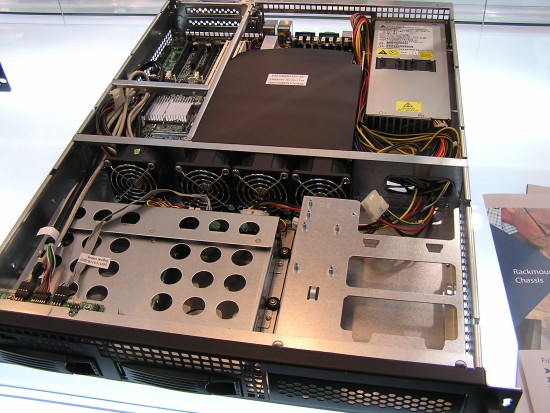CeBIT 2007: Storage & Servers
by Johan De Gelas on March 29, 2007 12:15 AM EST- Posted in
- Trade Shows
Others
Chenbro launched the first 1.5U server, the RM13204. The 1.5U height was necessary to accommodate some very specialized video cards which are used by the military.

Enermax showed how much hardware its Galaxy 1000W can power. According to Enermax, the PSU delivered 933 W to 24 80GB hard disks, four Opteron 8212 CPUs, four 3Ware 9650 drive controllers, a GeForce 7600GX and 8GB of RAM (16 x 512MB).

We also talked to the people of MDT, a German memory DIMM manufacturer which claims their automated module testing machines are able to pick out the best memory chips. To prove this claim, MDT promises to replace each bad MDT DIMM with two brand new DIMMs, or a 200% guarantee. It will be interesting to see if both their gaming DIMMs and server DIMMs are able to best (or even match) the other DIMM modules out there while maintaining competitive pricing.
Conclusion
As has been the case for a few years now, CeBIT featured very few really new launches of products, but there are some clear trends. First of all, we see renewed interest from Supermicro, Tyan, AMD, Sun and Intel in HPC. As HPC software is at the moment the only software that can never have enough CPUs and memory bandwidth, it is a clear target for even faster CPUs with even more cores.
In a similar vein, the first benchmark shows that AMD's newest K10 chip makes much better use of the available DDR2 bandwidth than the previous AMD generation. It is still unclear how the chip will perform in integer intensive applications, unfortunately; AMD will only tell us that the K10 is "significantly faster" in this respect than the competition on a clock for clock basis. Whether this will be enough for the 2.3 GHz K10 to outperform a 3 GHz Xeon x5365 remains to be seen. There are good indications that the AMD K10 will be the fastest chip in HPC however.
The second interesting trend is that companies like Supermicro and Promise are ambitious enough to break open the rather "closed and proprietary" markets such as SAN and Blade Servers. This is very promising as these products have traditionally been way too expensive for the smaller enterprises. We will definitely take a look at these products and try to determine if they are an attractive alternative to the Tier One OEM products.
Chenbro launched the first 1.5U server, the RM13204. The 1.5U height was necessary to accommodate some very specialized video cards which are used by the military.

Enermax showed how much hardware its Galaxy 1000W can power. According to Enermax, the PSU delivered 933 W to 24 80GB hard disks, four Opteron 8212 CPUs, four 3Ware 9650 drive controllers, a GeForce 7600GX and 8GB of RAM (16 x 512MB).

We also talked to the people of MDT, a German memory DIMM manufacturer which claims their automated module testing machines are able to pick out the best memory chips. To prove this claim, MDT promises to replace each bad MDT DIMM with two brand new DIMMs, or a 200% guarantee. It will be interesting to see if both their gaming DIMMs and server DIMMs are able to best (or even match) the other DIMM modules out there while maintaining competitive pricing.
Conclusion
As has been the case for a few years now, CeBIT featured very few really new launches of products, but there are some clear trends. First of all, we see renewed interest from Supermicro, Tyan, AMD, Sun and Intel in HPC. As HPC software is at the moment the only software that can never have enough CPUs and memory bandwidth, it is a clear target for even faster CPUs with even more cores.
In a similar vein, the first benchmark shows that AMD's newest K10 chip makes much better use of the available DDR2 bandwidth than the previous AMD generation. It is still unclear how the chip will perform in integer intensive applications, unfortunately; AMD will only tell us that the K10 is "significantly faster" in this respect than the competition on a clock for clock basis. Whether this will be enough for the 2.3 GHz K10 to outperform a 3 GHz Xeon x5365 remains to be seen. There are good indications that the AMD K10 will be the fastest chip in HPC however.
The second interesting trend is that companies like Supermicro and Promise are ambitious enough to break open the rather "closed and proprietary" markets such as SAN and Blade Servers. This is very promising as these products have traditionally been way too expensive for the smaller enterprises. We will definitely take a look at these products and try to determine if they are an attractive alternative to the Tier One OEM products.










13 Comments
View All Comments
Nehemoth - Thursday, March 29, 2007 - link
Well it was invented by AMD but was the code name for the Turion.Later indeed miss used over Internet....
Hope Barcelona be an Amazing chip, regards to AMD for the great products that Intel is Gave in us, yes sound really extrange but imagine where we would be if not for AMD..
CrystalBay - Thursday, March 29, 2007 - link
Fascinating analysis Johann ..JohanAnandtech - Thursday, March 29, 2007 - link
Thanks!With the current hints we got from Intel (Penryn Xeons might go to 3.6 GHz if necessary), I just hope AMD will do better than 2.3 GHz. Journalists like us need Epic battles ;-)